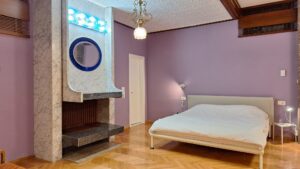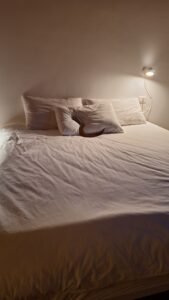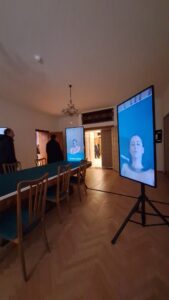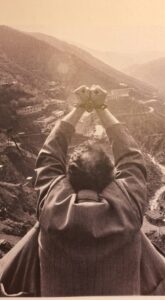Vila 31- a trip to the past
As a history lover, I approached the visit to this villa as an opportunity to see how the Dictator Enver Hoxha used to live with his family for 50 years.
I expected to see old furniture, rooms filled with distant memories, still holding an air of importance and fear. But that was not what I witnessed during this visit.


We entered the large gate that led us to a garden with fountains, small trees, and a front view of the entire villa. In the front yard, people were sitting on the ground in cushions, circling each other, talking about their thoughts and experiences. A minivan was selling beer to people so they could enjoy these chats while drinking something, much like a bar where you sit with your friends to talk. Combining this modern activity with the old villa was a brilliant idea.

We climbed the stairs leading to the central area of the villa. Paintings and photographs from different artists were on the walls and in the rooms, making the experience even more surreal. For a second, we forgot that we were inside the house of a dictator. The focus was not on history, on how the once most feared man in Albania lived, where he made all his decisions, called the people to enforce laws, or even to kill certain people. The narrative focused on these modern art pieces scattered everywhere in every room and corridor. Occasionally, I was confused about whether an object was a real object from the house or just a piece of art. And for it to be the first time opening this villa, I could say that I was highly disappointed. We can’t hide and erase a part of our history, a history that we should learn from today, so we don’t repeat it tomorrow.



Either way, I continued walking, hoping to see something relating to the house itself. Climbing the spiraling staircase, we arrived in the dictator’s office. The library was stunning; there were English, French, and Russian books containing different stories and autobiographies of different dictators. While reading the authors, I stumbled upon a small picture of a nude woman, left there without explanation. I had to ask my mother jokingly if the dictator himself owned this picture, or if it was just another “piece of art”. And of course, the dictator had nothing to do with it.
Most rooms were closed, so I didn’t have the chance to see everything, but the entire time I was there, I could only think of how disappointed I was to see this absurd art overshadowing our only dictator in history.


In my travels, I have seen other museums of communism in different European countries. To me, one open house museum was the most interesting one. A simple house in Sofia, Bulgaria, called the Red Flat, contains the history of a family in communist times, how they lived, what activities they did during the day, etc. I could only think of how beautiful the house of a normal citizen was shown in the form of a museum with storytelling, and how much potential this mystery villa had, being the most important villa during the dictatorship, the house of Enver Hoxha.


I think that the positive outcome of this would be to turn the villa in a museum, with all its original furnitures, including immersive experiences and storytelling so that we can spread the right message throughout everyone especially the young generation, that although the house is filled with rare furnitures, breathtaking lounge areas and pools, we have to know that while the dictator was living in luxury the rest of the people during the dictatorship, were living the most difficult years of their life.
Mevisa Xhuli, an Albanian student studying in Belgium
Tags:
Other News to Read
Vila 31- a trip to the past
Vila 31- a trip to the past, As a history lover, I approached the visit to this villa…
What to do in April 2025 in Tirana
April begins with numerous activities in Tirana. Some festivals feature music, art, and culture. April is also a…
The legend of April Witches in Albania
Raining and bad weather in the last week of March and the beginning of April is related to…
Heritage is Our Brand- a project or a mission
Albanians’ intangible heritage is wealthy, starting with their language, national symbols, folklore, costumes, legends, ballads, dances, rites, and…